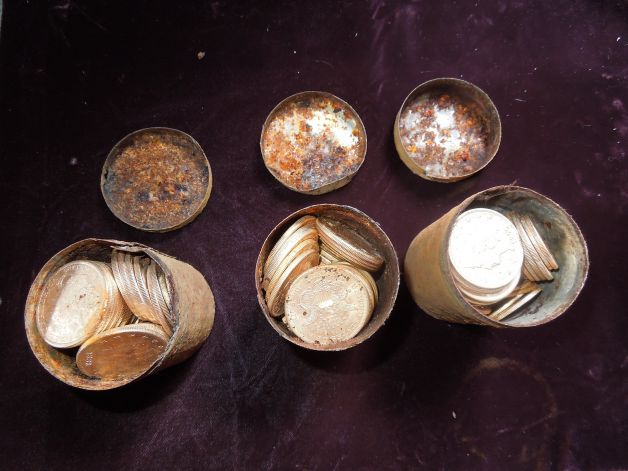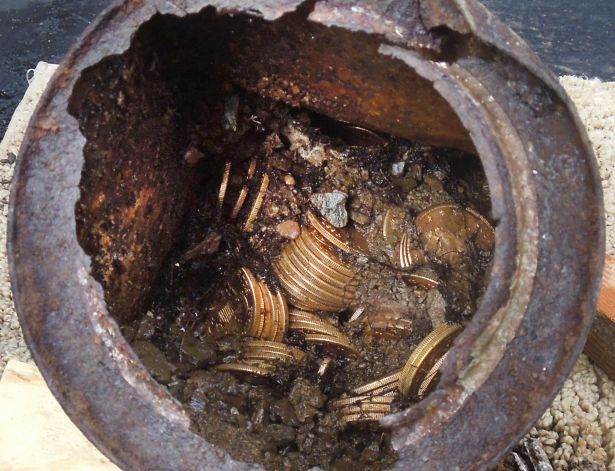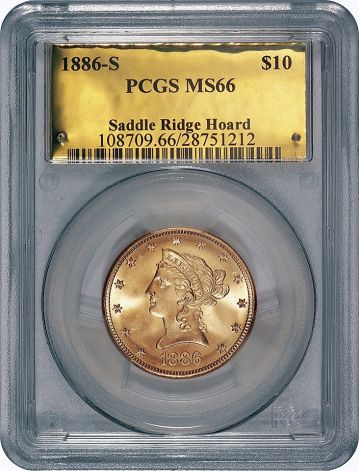SFGate | February 26, 2014 | by Kevin Fagan

Some dream of roaming the Earth to hunt buried treasure. One Sierra Nevada couple didn’t have to go that far. They dug it up in their backyard – about $10 million worth, in 19th century U.S. gold coins stuffed into rusty cans.
It’s believed to the biggest hoard of gold coins ever unearthed in the United States. And it’s going on sale soon.
The bonanza emerged last year as the man and woman were walking their dog on their property in the Gold Country and noticed the top of a decaying canister poking out of the ground.
They dug it out with a stick, took it to their house and opened it up. Inside was what looked like a batch of discs covered in dirt from holes rotted through the can.
They weren’t just discs.
A little brushing revealed nearly perfectly preserved $20 gold coins with liberty head designs on the front, dated from the 1890s. They ran back to the same spot, and when they were done digging, they’d found a total of eight cans containing 1,427 coins – with a face value of $27,980.
A total of 1,373 were $20 coins, 50 were $10 coins and four were $5 coins. They were dated from 1847 to 1894, and after sprucing up they shone like, well, gold – which fortunately never corrodes. About a third of the coins were in pristine condition, having never been circulated for spending. Most were minted in San Francisco.
“It was a very surreal moment. It was very hard to believe at first,” the man said in an interview taped by the rare-coin dealer he eventually consulted to make sense of the find. “I thought any second an old miner with a mule was going to appear.”

Staying secret
The couple are keeping their identities and location secret for many reasons, the main one being to prevent treasure hunters from ripping up their land with backhoes. But they’ve allowed coin dealer Don Kagin of Tiburon, who helped evaluate some of the biggest sunken treasure finds in history, to offer the collection up for sale.
It’s dubbed the Saddle Ridge Hoard, after the spot on the couple’s property where it was found. The collection is expected to sell for at least $10 million, either as a whole or in pieces, based on the evaluated condition of the coins.
“You hear all those Wild West stories of buried treasure, and you think they’re fantasies – well here, this one really did happen,” Kagin said the other day as he and his senior numismatist, David McCarthy, laid out dozens of the coins and cans for inspection at their office. “And what is almost unbelievable about this collection is what pristine condition so many of them are in.”
According to “American Coin Treasures and Hoards,” the bible of buried treasure finds, the biggest hoard of gold coins dug up before Saddle Ridge was a collection found by construction workers in Jackson, Tenn., in 1985. It had a face value of $4,500 and sold for $1 million.
Kagin and McCarthy met with the couple in April, two months after the hoard was dug up and the inevitable attorneys had gotten involved.
“The first thing the family did after finding all the cans was rebury them in a cooler under their woodpile,” McCarthy said. “They were terrified and had to think about what to do.”

‘Mind-blowing’ discovery
He said when he first sat with the couple to examine the find, “the family had cut little squares into some foam and put 18 of the coins in the squares in a cigar box. I pulled out the first coin, and it was from 1890. It had dirt on it, but when I looked close, it dawned on me just exactly what it was.
“I almost fell out of my chair. It was mind-blowing. I was literally sitting with the most amazing buried treasure I’ve ever heard of.”
He spent the next several months restoring the coins – a job so consuming that “my fingers bled,” McCarthy said. It then took until this month for them all to be appraised and readied for sale.
About 90 percent of the coins will post on Amazon.com’s Collectibles site, probably in May, Kagin said. The rest he will sell privately, “to well-heeled collectors who desire the finest and the rarest.”
The oddest of the bunch are an 1866 $20 coin minted in San Francisco without the words “In God We Trust” on the back – the words were added to those coins, called “Double Eagles,” later that year – and an 1849 $5 coin struck in the short-lived Dahlonega, Ga., mint.
Professional Coin Grading Service of Irvine, one of the world’s foremost coin-assessment firms, evaluated the hoard and certified that 13 of the coins are either the finest-preserved known examples of their kind, or tied for that rating.
Enduring mystery
How all that cash came to be underground in the Northern California mountains is a mystery. Was it loot from a stagecoach robbery? Some miser’s life savings?
“The family and the attorneys researched who might have put them there, and they came up with nothing,” Kagin said. “The nearest we can guess is that whoever left the coins might have been involved in the mining industry.” He also reckons the cans were buried at various times.
However or wherever they were found, the collection is going to rock the coin-collecting world, said Donn Pearlman, spokesman for the national Professional Numismatists Guild. Kagin will offer a presale glimpse of some of the coins at the American Numismatic Association’s National Money Show, a three-day event that starts in Atlanta on Thursday.
“It is always amazing when even a single gold coin is found, let alone more than 1,000 of them that date back to the Gold Rush era,” Pearlman said. “This will cause a tremendous amount of excitement.”
The couple, who are in their 40s and are self-employed, told Kagin and McCarthy they want to donate some of the proceeds to the homeless and hungry in their area. They also plan to keep a few coins as keepsakes.
“Like a lot of people lately, we’ve had some financial trials,” the man told Kagin in the recorded interview. “I feel extreme gratitude that we can keep our beloved property.”
The couple didn’t sound like they were suddenly going to live large, though. “We love our lives as they are,” the woman said.
Pieces of history
Kagin, whose 81-year-old outfit is the nation’s oldest family-owned numismatic firm, said he’s planning to send buyers a write-up of the collection’s place in Gold Country history. He did similar research when consulting on the gold chunks and coins fetched from the record-setting shipwrecks of the steamships Central America ($130 million value, in 1987) and Republic ($60 million value, in 2003).
“This is not just a bunch of coins found in a bunch of cans,” Kagin said. “Coins like this are art, and some of the best artifacts we have of characteristics of our society.
“You look at these coins,” he said, gazing at a dozen of the “Double Eagles” spread before him, “and you see history. They are the Gold Rush, murders in the mountains, buried treasures, the Wild West, everything of that time.
“And it’s all right here before you. You can hold it in your hands. Amazing.”
Kevin Fagan is a San Francisco Chronicle staff writer. E-mail: kfagan@sfchronicle.com
See more Photographics at SFGate









